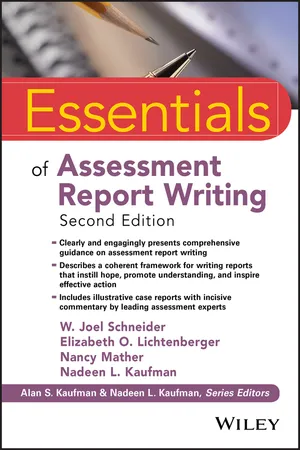
Essentials of Assessment Report Writing
- English
- ePUB (mobile friendly)
- Available on iOS & Android
Essentials of Assessment Report Writing
About This Book
The bestselling guide to reporting writing, updated and reworked for today's practice
Essentials of Assessment Report Writing offers effective solutions to the creation of reader-friendly, yet targeted, psychological, and educational assessment reports. Parents, clinicians, clients, and other readers need more than test-by-test descriptions—they need an accessible analysis of the entire situation to determine their next steps. This book provides clear guidance for busy practitioners seeking ways to improve their report writing skills. With a focus on current practice, this new second edition covers DSM-5 updates and the latest assessment instruments including the WJ IV, WISC-V, WAIS-IV, KTEA-3, and the CAS2. New discussion includes advice on tailoring the report to the audience, and annotated case reports provide illustrative models of effective report styles, interpretation, and analysis. Key concepts are highlighted for quick reference throughout, and end-of-chapter questions help reinforce understanding.
Reporting styles vary widely within the field, in both content and style; there is no definitive "standard, " but many reports fail to reflect best practices and therefore prove less than useful to the reader. This book provides expert guidance throughout the reporting process to help practitioners provide high-quality, accessible reports.
- Integrate assessment results to provide a person-centered report
- Identify and navigate critical decision points in the interpretive process
- Write efficiently yet effectively while enhancing the reader's experience
- Provide an accurate, informative, and readable assessment report
- Incorporate practical recommendations to address the referral concerns
Expertly-conducted assessments should culminate with a carefully constructed analysis that provides direction via clear communication. Because this report will be used to inform treatment, intervention, and ultimately, the client's quality of life—it is critical that it provides clear, informative guidance in a way that readers can understand. Essentials of Assessment Report Writing provides comprehensive guidelines for navigating through the report writing process.
Frequently asked questions
Information
One
INTRODUCTION AND OVERVIEW
THE ESSENTIALS OF ASSESSMENT
DON’T FORGET
DISTRACTING PRIORITIES IN THE REPORT‐WRITING PROCESS
Accuracy Versus Clarity
Table of contents
- Cover
- Series Page
- Title Page
- Copyright Page
- Dedication Page
- Series Preface
- Preface to the Second Edition
- Acknowledgements
- Chapter One: Introduction and Overview
- Chapter Two: Make Your Reports Classy and Gorgeous
- Chapter Three: Writing with Clarity, Style, and Purpose
- Chapter Four: Introductory Sections of the Report
- Chapter Five: Behavioral Observations
- Chapter Six: Communicating Test Results
- Chapter Seven: Diagnostic Impressions and Summary
- Chapter Eight: Personality Assessment
- Chapter Nine: Recommendations
- Chapter Ten: Special Issues in Report Writing
- Chapter Eleven: Tips for Writing Evaluation Reports
- Chapter Twelve: Annotated Case Reports
- References
- Index
- End User License Agreement